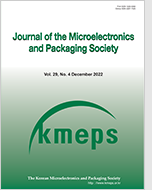
Search
- Past Issues
- e-Submission
-

KCI Accredited Journals KCI 등재지
KCI Impact Factor 0.54
Editorial Office
- +82-2-538-0962
- +82-2-538-0963
- kmeps@kmeps.or.kr
- http://kmeps.or.kr/

KCI Accredited Journals KCI 등재지
KCI Impact Factor 0.54
Journal of the Microelectronics and Packaging Society 2024;31(3):24-37. Published online: Oct, 30, 2024
DOI : doi.org/10.6117/kmeps.2024.31.3.024
Due to the thin nature of semiconductor packages, even minor thermal loads can cause significant warpage, impacting product reliability through issues like delamination or cracking. The mold curing process, which encloses the package to protect the semiconductor chip, is particularly challenging to predict due to the complex thermal, chemical, and mechanical interactions. This study proposes a cost-effective machine learning model to predict warpage in the mold curing process. We developed methods to characterize the curing degree based on time and temperature and quantify the material's mechanical properties accordingly. A Finite Element Method (FEM) simulation model was created by integrating these properties into ABAQUS UMAT to predict warpage for various design factors. Additionally, a Warpage formula was developed to estimate local warpage based on the package's stacking structure. This formula combines bending theory with thermo-chemical-mechanical properties and was validated through FEM simulation results. The study presents a method to construct a machine learning model for warpage prediction using this formula and proposes a cost-effective approach for building a training dataset by analyzing input variables and design factors. This methodology achieves over 98% prediction accuracy and reduces simulation time by 96.5%.
Keywords Warpage, Curing process, FEM simulation, Cost-effective, Physics informed machine Learning